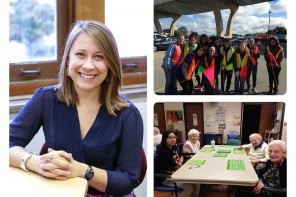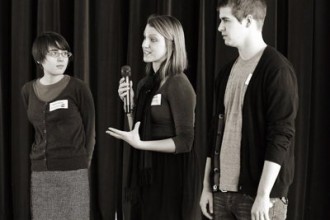By Mary Diez — When we think about wonderful teachers, it’s probably their impact on young people that is at the forefront of our minds.
In the nomination process for the awards to be given to 10 teachers by the Education Deans of Greater Milwaukee at the Celebration of Teachers & Teaching Event on October 17, we saw again and again how principals, kids, and parents testified to the difference these teachers have made on the young people in their care.
What makes these teachers so good?
Some people may argue that teachers are born, not made. There may be a grain of truth in that saying, but it’s also true that good teachers are themselves great learners who build on every experience they’ve had to contribute to their repertoire for teaching. Some people are currently lobbying policy makers to restrict the pathways to teaching, based on g.p.a.’s and standardized tests; again, there may be value in looking at academic performance on some measures, but it’s also true that less easily measured attributes also make a huge difference. Think about the ability to help students make connections across subject areas or to really listen to what a student needs in the moment to be successful in learning. Those are attributes that a g.p.a. or multiple choice tests are unlikely to reveal.
It turns out that we know a lot about what it takes to have impact on student learning, and our learning comes both from research and from the wisdom of practice. What teachers need to know, be able to do, and hold as dispositions is captured in the Interstate Teacher Assessment and Support Consortium (InTASC) Model Core Teaching Standards, published in 2011 by the Council of Chief State School Officers. These standards have been adopted by the Wisconsin Department of Public Instruction to guide the state’s work with educator effectiveness. I was privileged to co-chair the group who developed these standards, many of whom were state teachers of the year and teachers who have been certified by the National Board for Professional Teaching Standards.
The InTASC Model Core Teaching Standards are organized in two ways. First, the format for each standard spells out the performances that show good teaching in practice. Then, it outlines the essential knowledge needed to back up the performances and the critical dispositions that guide performance. For example, if a teacher is to demonstrate that she can engage “learners in developing higher order questioning skills,” the essential knowledge would include both deep knowledge of the subject and solid understanding of cognitive processing. And a critical disposition would be the teacher’s commitment to make it possible for all students to achieve at high levels.
Looking at the standards makes it very clear that teaching is complex and requires focused effort on the part of practitioners. For most people, developing what the standards demand requires the kind of strong teacher education programs that we have in the Milwaukee metro area. The standards are organized in four clusters—addressing the learner and learning, content, instructional practice, and professional responsibility. These divisions makes it possible to look at aspects of teaching in order to understand the demands of practice, but of course in practice all four are functioning when teachers are at work.
Where Teaching Starts: The Learner and Learning
Teaching begins with focusing on the learners. Teachers need to know quite a lot about typical development of learners across the age span, while also recognizing that developmental patterns vary among individuals. And development is complex–involving cognitive, linguistic, social, emotional, and physical growth. Teachers need to understand individual differences and diverse cultural backgrounds in order to build inclusive environments capable of supporting all their learners. Building a learning culture—both in the individual classroom and in the school as a whole—clearly calls for a range of knowledge and skill, supported by dispositions of commitment to reach every learner.
I hope that you will be on the watch for stories about the teachers to be honored on October 17; each one is a strong representative of the best of the profession. One of the required entries each submitted was a picture or a video of their classroom. The criterion for selection asked the teacher to use the picture of their classroom to “explain how concrete and sustained actions build a climate of high expectations and high support for learners.”
How It Continues: Content
It’s a given that teachers need a deep knowledge of content—and that they can flexibly draw upon their knowledge as they work with learners to apply knowledge in real world settings. The 2011 standards raised the bar from the original 1992 standards by setting the expectation that teachers guide students in connecting concepts from varied subjects and help them engage with content to practice critical thinking, creativity, and collaborative problem solving. These are standards for the 21st Century.
The process for selecting the 2013 honorees asked for concrete evidence of how the teacher “works with learners to build their knowledge and skills,” with a resulting impact on learner growth and development that shows up in multiple measures and performance. It was delightful to see how teachers from kindergarten through high school crafted experiences to making learning real and relevant for their learners.
How It Builds: Instructional Practice
This set of standards describes key aspects of the work that teachers do every day: Assessment, Planning for Instruction, and Instructional Strategies. Teachers work with state standards and local curriculum to identify objectives, and then determine what their learners already know and can do through assessment to refine specific goals in planning. Their knowledge of learners also guides their choice of instructional strategies to engage learners and maximize their learning in individual ways.
In the submissions for the 2013 awards, teachers submitted a letter from either a parent or a student, providing “concrete examples, explicitly linking the teacher’s classroom practice to the student’s life, school performance, attitude, etc.” Those being honored this year clearly were lauded for how they helped young people engage with learning. Their impact affected performance measures, but it also went well beyond, touching the learners’ confidence and love of learning.
How It Extends Outside the Classroom: Professional Responsibility
As professionals, teachers not only focus on their primary responsibilities in the classroom, but also engage in ongoing growth in a variety of ways. For example, they continue to study and grow through professional development, self-reflection, and collaboration with colleagues. They contribute to improvement of practice beyond their own classroom and support parents as the first educators of their children. Those being honored in the Advanced Practice category, particularly, are also making a difference in content area associations, district-wide committees, or other groups that extend their influence beyond their classroom and school.
The teachers being honored in 2013 have made a difference not only in their own classrooms with their own students, but in their schools and professional organizations. Their principals and the deans of their schools of education noted especially their commitment to ongoing improvement and their generosity in working with others to share what they have learned. For example, many have opened their classrooms to field work students or student teachers, sharing their practice with those entering the profession.
The selection process for the 2013 Celebrate Teachers and Teaching event was rigorous, seeking to identify excellent teachers in urban schools. Not only did it take time to produce the required entries, but these entries were judged against some demanding criteria by a group of impressive judges drawn from the wider community. We’re proud of all of those being honored this year. Please help us celebrate their accomplishments on October 17!
And watch for details on the Celebrate Teachers and Teaching award program for 2014. The theme for next year is Service Learning, so we will be seeking nominations of teachers who engage their learners in projects that both provide service to others and contribute to the learners’ awareness, understanding, and application of concepts and skills.
________________
Mary E. Diez, PhD is professor in the School of Education at Alverno College. Dr. Diez is former president of the American Association of Colleges for Teacher Education (AACTE). She has served on the National Board for Professional Teaching Standards (NBPTS) and the National Council for Accreditation of Teacher Education (NCATE). Currently, Dr. Diez chairs AACTE’s task force on teacher education as a moral community. She is director of a number of projects at Alverno College that support urban public schools. She has worked with preparation of teachers for National Board certification and professional development focused on integrated curriculum, service learning, and performance assessment.


 i evaluate to yes even if there's no image
i evaluate to yes even if there's no image  i evaluate to yes even if there's no image
i evaluate to yes even if there's no image  i evaluate to yes even if there's no image
i evaluate to yes even if there's no image 